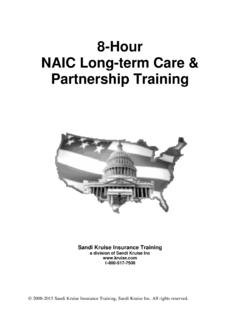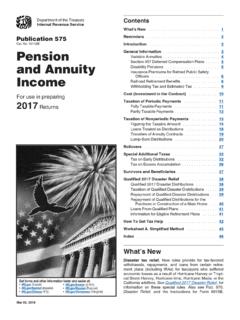Transcription of California Insurance Agents’ 4-Hour Annuity Training ...
1 California Insurance Agents 4- hour Annuity Training Course How Fixed, Variable, and Index Annuity contract Provisions Affect Consumers Sandi Kruise Insurance Training Quality Education for Insurance Professionals 1-800-517-7500 2 (c) Copyright Sandi Kruise Insurance Training 10-29-2012 Contents Curriculum Objective Training Goals .. 4 I. Identify and discuss suitability 5% .. 5 A. Licensing requirements for life-only agents .. 15 1. Training (section of the CIC) .. 15 B. Checklist as required by Section (e) of the CIC .. 15 C. Insurer responsibilities as required by Section (f)(D) and (E) of the CIC .. 16 II. Identify and discuss contract provisions that are typically common to annuities 10%.
2 18 A. Issues ages (Section 10112 of the CIC) .. 18 B. Maximum ages for benefits to begin .. 19 C. Premium payments (Section 10540 of the CIC) .. 19 D. Surrender charges (Section , , and of the CIC) .. 20 1. Market value adjustment .. 22 2. Explain the impact of surrender charges on principal .. 22 3. Surrender charge waivers - triggering events .. 22 a. Nursing homes and similar facilities .. 23 b. Terminal illness .. 23 c. Unemployment .. 23 d. Disability .. 24 e. Charges and fees .. 24 f. Death .. 24 4. Include the required notice & printing requirements .. 25 E. Policy administration charges and fees .. 25 F. Withdrawal privilege options .. 25 III. Identify and discuss income distributions 10% .. 27 A. Introduce the application of a split Annuity in retirement planning.
3 27 B. Introduce the various settlement options .. 28 1. Life .. 28 2. Joint survivor .. 28 3. Period certain .. 28 4. Cash refunds .. 28 C. Discuss the advantages and disadvantages of annuitization options .. 28 IV. Identify and discuss variable annuities 10% .. 30 A. Additional License requirements .. 33 1. Prospectus .. 33 2. Financial Industry Regulatory Authority (FINRA) .. 34 B. Typically common contract provisions .. 34 1. General vs. separate accounts .. 34 2. Variable options .. 35 3. Equity-based .. 36 4. Risk-based .. 37 C. Charges and fees .. 38 D. Dollar cost averaging .. 40 E. Death benefit guarantees (Section of the CIC) .. 41 F. Living benefit guarantees .. 41 V. Identify and discuss fixed annuities 25% .. 43 A. Typically common contract provisions.
4 44 3 (c) Copyright Sandi Kruise Insurance Training 10-29-2012 1. Death benefits .. 44 a. Lump sum vs. annuitization .. 45 b. Provisions .. 45 2. Charges and fees .. 45 3. Interest rate strategies .. 46 a. Annual .. 46 b. Multi-year .. 46 4. Interest rate crediting methods .. 46 a. Portfolio rates .. 46 b. New money rates .. 46 c. First year bonus teaser rates .. 47 d. Explain annualized interest rate calculations on bonuses that apply to fixed accounts .. 47 5. Minimum Guaranteed Interest Rates (Section of the CIC) .. 48 a. Low interest rate market and its impact on interest rates .. 48 VI Identify and discuss indexed annuities 25% .. 49 A.
5 Primary interest crediting strategies .. 51 1. Monthly 51 2. Point to point .. 51 a. Annual point to point .. 52 b. Long term point to point .. 52 3. High water mark .. 52 4. Annual 52 5. Combination methods .. 53 B. Spreads .. 53 C. Cap rates .. 53 D. Participation rates .. 53 E. Minimum guaranteed interest rate .. 54 F. Impact of premature surrender charges .. 55 1. Two-tier annuities - define concepts .. 55 G. Charges and fees .. 55 VII Identify and discuss available riders 10% .. 57 A. Life Insurance 57 B. Long term care benefits riders .. 57 1. Terms of riders .. 58 2. Differentiate between crisis waivers and long term care riders .. 58 C. Skilled nursing facility rider .. 59 D. Hospice rider .. 59 E. Loan provisions .. 59 VIII. Penalties (Section 782, , , et seq.)
6 Of the CIC)(Attachment III) 5% .. 60 A. Violation of provisions in Section 780 or 781 of the CIC (Section 782 of the CIC) .. 60 B. Administrative penalty, amounts, rescission of contracts (Section of the CIC) .. 60 C. Allegations of misconduct against a person 65 year or over (Section of the CIC) .. 61 D. Administrative penalties (Section of the CIC) .. 62 Attachment III Penalties defined .. 62 4 (c) Copyright Sandi Kruise Insurance Training 10-29-2012 California Department of Insurance Course Goals and Objectives: Curriculum Objectives Training Goals At the conclusion of this four- hour course, the student must: Understand the producer s legal and ethical obligations toward the consumer (and to the insurer and to regulatory authorities) with regard to the suitability of Annuity product recommendations; Be able to define suitability; Be able to define the types of information that must be obtained from the consumer in order to make suitable Annuity product purchase recommendations.
7 Be able to identify the product features and circumstances where an Annuity product would be suitable and it would be unsuitable for a consumer; Understand the processes in place to audit and supervise producer activities; Identify the regulatory requirements that have been enacted to protect the senior consumer during the purchase and exchange of Annuity products; Identify how violations of suitability standards may be identified; and, Know and understand the penalties provided for violations of applicable laws. These courses should not be used as an opportunity to persuade, indoctrinate or enlighten agents on a particular philosophy, a political or a public policy position. Opinions about state or federal legislation or forecasting the success or failure of legislation should not be included in these courses. Moreover, absolutely no marketing information is allowed in Annuity courses.
8 Disclaimer - The California Department of Insurance is released of responsibility for approved course materials that may have a copyright infringement. In addition, no course approved for either prelicensing or continuing education hours or any designation resulting from completion of such courses should be construed to be endorsed by the Commissioner. Section of the California Insurance Code took effect on January 1, 2005. This law requires that California resident and non-resident life agents who sell Annuity products must first complete eight (8) hours of Annuity Training that is approved by the California Department of Insurance (CDI). In addition, the law also requires life agents who sell Annuity products to satisfactorily complete an additional four hours of Annuity Training every two years prior to their license renewal. For resident agents, this requirement is part of, and not in addition to, their continuing education requirements.
9 In addition, Assembly Bill (AB) 689 (Chapter 295, Statutes of 2011) Insurance Annuity Transactions became effective January 2, 2012. AB 689 adds Section (a) to the California Insurance Code which states that an Insurance producer must not solicit the sale of an Annuity product unless the Insurance producer has adequate knowledge of the product to recommend the Annuity and the Insurance producer is in compliance with the insurer s standards for product Training . Insurance producers may rely on insurer-provided product-specific Training standards and materials to comply with the product-specific Training requirement. Please note that AB 689 does not change the Annuity Training requirements which are stated in Section of the California Insurance Code. The Annuity product-specific Training is a separate requirement from the eight and four- hour Annuity Training noted above.
10 5 (c) Copyright Sandi Kruise Insurance Training 10-29-2012 California Annuity 4 hour CE Course I. Identify and discuss suitability 5% When recommending that individual consumers, including those over the age of 65, purchase or exchange an Annuity , the Insurance producer (or insurer where no producer is involved), must have reasonable grounds for believing that the recommendation is suitable for the individual consumer on the basis of the facts disclosed by the individual consumer as to his or her investments and other Insurance products and as to his or her financial situation, needs, and objective. SUITABILITY Suitability is defined as a sale or recommendation that meets the needs and goals of a person based upon reasonable inquiry concerning the person s Insurance objectives, financial situation, age and other relevant information.












